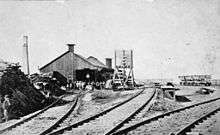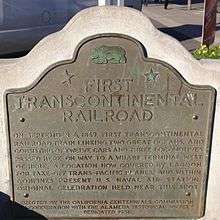Alameda Terminal
Alameda Terminal (a.k.a. Alameda Wharf) was a railroad station and ferry wharf at the foot and west of present-day Pacific Avenue and Main Street in Alameda, California, on the eastern shore of San Francisco Bay with ferry service to San Francisco.[3][1]:10-11 It was built in 1864 and operated by the San Francisco and Alameda Railroad. In 1869, it served as the original west coast terminus of the U.S. First Transcontinental Railroad, [1]:7 until the opening of Oakland Pier two months later. The western terminus was inaugurated September 6, 1869, when the first Western Pacific through train from Sacramento reached the shores of San Francisco Bay at Alameda Terminal,[4] thus completing the first transcontinental railroad to the Pacific coast.
| Alameda Terminal | |
|---|---|
 Alameda Terminal, ca. 1869 | |
| Location | Naval Air Station Alameda Alameda, California |
| Built | 1864 by the San Francisco and Alameda Railroad (1864-1870)[1]:7 |
| Designated | June 8, 1949[2] |
| Reference no. | 440[2] |
History
The Pacific Railroad Act passed by the United States Congress in 1862 authorized construction of the First transcontinental railroad and telegraph line, which included connecting the Central Pacific Railroad in the west with the Union Pacific Railroad in the east. In 1863, the first construction activity took the Central Pacific line eastward from Sacramento. In October 1864, the Central Pacific Railroad assigned all the rights of the Pacific Railway Acts of 1862 and 1864 to the Western Pacific Railroad for the route between Sacramento and San Jose, including land grants. The plan was that the transcontinental railroad would follow the Western Pacific to San Jose and then connect with the San Francisco and San Jose Railroad (SF&SJ), completed in 1864, to San Francisco.
By 1866, Western Pacific had built 20 miles (32 km) of track north and east from San Jose, reaching halfway into Niles Canyon, to about Farwell near MilePost33.[5] The Western Pacific used 500 Chinese laborers to grade and construct the rail line into the rugged canyon with its tight curves and narrow banks.[6] Construction was then halted because of disagreements between the railroad’s contractors and its financiers.[5]
In 1868, Central Pacific Railroad, a subsidiary of which had acquired the Western Pacific and later Oakland Point, restarted work on the Western Pacific Railroad line starting at Sacramento working southward, as well as near Lathrop and Livermore, using upwards to 2,000 Chinese laborers. The new plan was to connect with Oakland and Oakland Point with its ferry service to San Francisco. In June 1869, work resume with track laying in Niles Canyon working towards Livermore. Also in June 1869, J. H. Strobridge came to Niles (then Vallejo Mills and now part of Fremont) to oversee the construction of the new line, with his crew of up to 600 Chinese laborers, heading towards Oakland.[7] In September 1869, a temporary connection was made at a junction called Simpson's or Melrose at San Leandro with the old tracks of San Francisco and Alameda Railroad, which led to the SF&A Alameda Wharf with ferry service to San Francisco.[1]:8
On September 6, 1869, the first Western Pacific train reached the shores of San Francisco Bay at Alameda Terminal, thus achieving the transcontinental Pacific Railroad envisioned in the 1862 Pacific Railroad Act. According to the Daily Alta California, this first through train left Sacramento at 10 am, got delayed by some construction trains, exited Niles Canyon late at 9:30 pm, and an hour later arrived at Alameda Terminal to a cheering crowd.[4] Two months later, Central Pacific Railroad switched the western transcontinental terminus to its expanded Oakland Pier, which was inaugurated on November 8, 1869, in another round of celebration.[8]
New York and Oakland are bound together by ties strapped with iron.[8]
Alameda then went back to local train service only. In 1870 the SF&A was absorbed into Central Pacific and in 1873 the original SF&A pier was abandoned.[1]:9
Present day

The railroads and their wharfs are gone from Alameda. The last rails were removed in 1960 from Lincoln Ave (formerly Railroad Ave and along which the SF&A rails ran).[1]
The achievement of the first transcontinental railroad reaching Alameda Terminal on September 6, 1869 is marked by a plaque in the Naval Air Station Alameda and a California Historical Landmark (CHL #440) nearby.[2] The GPS coordinates of the two markers are given respectively by 37.786779,-122.30292 (plaque); and 37.77535,-122.276891 (CHL #440).[9][10]
On 6 September 2019, a "golden spike" ceremony was held in Niles Canyon, where the Western Pacific tracks laid in 1866 was linked with the Central Pacific tracks laid in 1869,[11][12] commemorating the 150th anniversary of the 6 September 1869 completion of the first transcontinental railroad to the original Pacific coast terminus at Alameda Terminal.[13] Also, the mayor of the City of Alameda issued a proclamation recognizing "the outstanding contributions of the many Chinese immigrants who helped make the Transcontinental Railroad a reality".[14]
See also
- Alameda Mole
- First transcontinental railroad
- Niles Canyon Railway
- Oakland Long Wharf
- San Francisco and Alameda Railroad
- San Francisco and Oakland Railroad
- San Francisco and San Jose Railroad
- Western Pacific Railroad (1862-1870)
References
- Ute, Grant; Singer, Bruce (2007). Alameda by rail. San Francisco, CA: Arcadia Publishing. ISBN 978-0-7385-4706-0.
- "Alameda Terminal of the First Transcontinental Railroad". Office of Historic Preservation, California State Parks. Retrieved 2012-10-05.
- Mosier, Page; Mosier, Dan (1986). Alameda County Place Names. Fremont, CA: Mines Road Books.
see map 3 for the location of Alameda Wharf
- "The first through train on the Western Pacific Road". cdnc.ucr.edu. Daily Alta California 7 September 1869 — California Digital Newspaper Collection. Retrieved 2018-06-20.
- Luna, Henry; Pacific Locomotive Association (2005). Niles Canyon Railways. San Francisco, CA: Arcadia Publishing. ISBN 0-7385-2983-4.
Western Pacific became the first railroad into Niles Canyon when their first 20-mile section of track was built from San Jose to a point in the canyon just beyond Farwell, when construction halted.
- "Niles Canyon Transcontinental Railroad Historic District". National Park Service. June 2018. Retrieved 10 May 2019.
- "Again in the field -- the Western Pacific Railroad". Sacramento Daily Union. June 5, 1869. Retrieved 5 June 2019.
J. H. Strobridge, ...to commence work upon the branch of the Western Pacific Railroad leading from Vallejo Mills to Oakland.
- "Railroad celebration at Oakland". California digital newspaper collection. Daily Alta California, Volume 21, Number 7172, 9 November 1869. Retrieved 10 May 2019.
New York and Oakland are bound together by ties strapped with iron.
- "California State Historical Landmarks". landmarkquest.com. Retrieved 2 July 2019.
- "Alameda Terminus of the 1st Transcontinental Railroad". HMdb.org. Retrieved 15 December 2019.
- "'Golden Spike' Ceremony Held To Honor Niles Canyon Railway". patch.com. Retrieved 31 October 2019.
- Moll, Raphaël. "Niles Canyon Railway Transcontinental Celebration 2019-09-06". youtube.com. Retrieved 31 October 2019.
- Evanosky, Dennis (5 September 2019). "Transcontinental Railroad Arrived 150 Years Ago". Alameda Sun. Retrieved 31 October 2019.
- Ashcraft, Marilyn Ezzy (September 2019). "Proclamation: Transcontinental railroad recognition" (PDF). AlamedaCA.gov. Retrieved 6 November 2019.